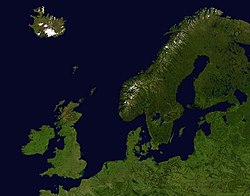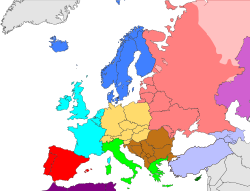Northern Europe
This article needs additional citations for verification. (June 2015) |

The northern region of Europe has several definitions. A restrictive definition may describe Northern Europe as being roughly north of the southern coast of the Baltic Sea, which is about 54°N, or may be based on other geographical factors such as climate and ecology.
During the Early Middle Ages, the Roman Catholic Church expanded into Northern Europe and spread Christianity among the Germanic peoples.[1] Christianity reached the peoples of Scandinavia and the Baltic region in later centuries. The Latin alphabet along with the influence of Western Christianity spread northward from Rome, leading to written English, German, Dutch, Danish, Norwegian, Swedish, Icelandic, Latvian, Estonian, Finnish and Sami languages. During the Protestant Reformation, which began in Northern Europe according to some looser definitions of the region, Protestantism was embraced in Northern Europe to an extent unseen in other parts of Europe, and the vast majority of Northern European countries, by any definition, are mostly Protestant historically.
Climate

The climate is mainly Oceanic climate (Cfb), Humid continental climate (Dfb), Subarctic climate (Dfc and Dsc), and Tundra (ET).
Geography
Northern Europe might be defined roughly to include some or all of the following areas: British Isles, Fennoscandia, the peninsula of Jutland, the Baltic plain that lies to the east and the many islands that lie offshore from mainland Northern Europe and the main European continent. In some cases, Greenland is also included, although it is only politically European, comprising part of the Kingdom of Denmark, and not considered to be geographically in Europe.
The area is partly mountainous, including the northern volcanic islands of Iceland and Jan Mayen, and the mountainous western seaboard, Scotland and Scandinavia, and also often includes part of the large plain east of the Baltic sea.
The entire region's climate is at least mildly affected by the Gulf Stream. From the west climates vary from maritime and maritime subarctic climates. In the north and central climates are generally subarctic or Arctic and to the east climates are mostly subarctic and temperate/continental.
Just as both climate and relief are variable across the region, so too is vegetation, with sparse tundra in the north and high mountains, boreal forest on the north-eastern and central regions temperate coniferous forests (formerly of which a majority was in the Scottish Highlands and south west Norway) and temperate broadleaf forests growing in the south, west and temperate east.
Classifications
There are various definitions of Northern Europe which often include the British Isles, the Nordic countries and the Baltic states and sometimes Greenland, northern Germany, northern Belarus and northwest Russia.
UN geoscheme classification

The United Nations geoscheme is a system devised by the United Nations Statistics Division (UNSD) which divides the countries of the world into regional and subregional groups, based on the M49 coding classification. The partition is for statistical convenience and does not imply any assumption regarding political or other affiliation of countries or territories.[2]
In the UN geoscheme, the following countries are classified as Northern Europe:[2]
as well as the dependent areas:
EuroVoc

EuroVoc is a multilingual thesaurus maintained by the Publications Office of the European Union, giving definitions of terms for official use. In the definition of "Northern Europe", the following countries are included:[3]
as well as the dependent area:
In this classification Jersey, Guernsey, the Isle of Man, the United Kingdom and Ireland are included in Western Europe.
CIA World Factbook

In the CIA World Factbook, the description of each country includes information about "Location" under the heading "Geography", where the country is classified into a region. The following countries are included in their classification "Northern Europe":[4]
as well as the dependent areas:
In this classification Jersey, Guernsey, the Isle of Man, the United Kingdom and Ireland are included in Western Europe, while Estonia, Latvia and Lithuania are included in Eastern Europe.
World Geographical Scheme for Recording Plant Distributions

The World Geographical Scheme for Recording Plant Distributions is a biogeographical system developed by the international Biodiversity Information Standards (TDWG) organization, formerly the International Working Group on Taxonomic Databases. The WGSRPD standards, like other standards for data fields in botanical databases, were developed to promote "the wider and more effective dissemination of information about the world's heritage of biological organisms for the benefit of the world at large". The system provides clear definitions and codes for recording plant distributions at four scales or levels, from "botanical continents" down to parts of large countries. The following countries are included in their classification of "Northern Europe":[5]
as well as the dependent areas:
Demographics


Countries in Northern Europe generally have developed economies and some of the highest standards of living in the world. They often score highly on surveys measuring quality of life, such as the Human Development Index. Aside from the United Kingdom, they generally have a small population relative to their size, most of whom live in cities. The quality of education in much of Northern Europe is rated highly in international rankings, with Estonia and Finland topping the list among the OECD countries in Europe.
During the Medieval period, the Germanic and Baltic peoples in Northern Europe were Christianised, with the Sámi being the last peoples to be converted in the 18th century.[6] Most peoples living in Northern Europe are traditionally Protestant Christians, although many are non-practising. There are also growing numbers of non-religious people and people of other religions, especially Muslims, due to open immigration policies. In the United Kingdom, there are also significant numbers of Indian religions such as Hindus and Sikhs, due to the large South Asian diaspora.
The Hansa group in the European Union comprises most of the Northern European states, plus the Netherlands.
See also
- Archaeology of Northern Europe
- Arctic
- Arctic Circle
- Baltic languages
- Baltic region
- Baltic states
- Baltoscandia
- British Isles
- Celtic languages
- Celtic nations
- Central Europe
- Council of the Baltic Sea States
- Crown Dependencies
- Eastern Europe
- European Free Trade Association
- Euroregion Baltic
- Finno-Ugric languages
- Germanic languages
- List of Intangible Cultural Heritage elements in Northern Europe
- List of World Heritage Sites in Northern Europe
- New Hanseatic League
- Nordic-Baltic Eight
- Nordic Battlegroup
- Nordic Council
- Nordic countries
- Nordic cross flag
- Nordic Estonia
- North Sea Region
- Northern Dimension
- Northern European Gymnastics Championships
- Northern Future Forum
- Northwestern Europe
- Roadex Project
- Sápmi
- Scandinavia
- Southern Europe
- UK Joint Expeditionary Force
- Vifanord
- Western Europe
References
- ^ Tanner, Norman. New Short History of the Catholic Church. p. 41.
- ^ a b "UNSD — Methodology". unstats.un.org. Retrieved 17 June 2019.
- ^ Publications Office of the European Union. "EU Vocabularies 7206 Europe". EuroVoc.
- ^ CIA. "The World Factbook".
- ^ Brummitt, R. K. (2001). World Geographical Scheme for Recording Plant Distributions (PDF) (2nd ed.). International Working Group on Taxonomic Databases For Plant Sciences (TDWG). Archived from the original (PDF) on 25 January 2016. Retrieved 27 July 2021.
- ^ Kenneth Scott Latourette, A history of expansion of Christianity. Vol 2. The thousand years of uncertainty: AD 500–AD 1500 (1938) pp. 106–43.
External links
 Media related to Northern Europe at Wikimedia Commons
Media related to Northern Europe at Wikimedia Commons
